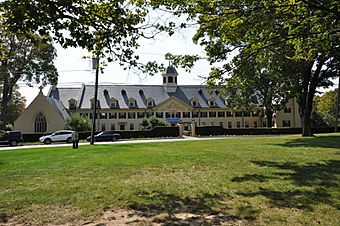Middlebury Center Historic District facts for kids
Quick facts for kids |
|
|
Middlebury Center Historic District
|
|

The Westover School
|
|
| Location | Roughly bounded by Library Rd., North and South Sts., and Whittemore Rd., Middlebury, Connecticut |
|---|---|
| Area | 103 acres (42 ha) |
| NRHP reference No. | 85001019 |
| Added to NRHP | May 9, 1985 |
The Middlebury Center Historic District is a special area in Middlebury, Connecticut. It includes the historic heart of the town. This district is where you'll find old churches, schools, and town buildings. Many of these structures were built in the late 1800s or early 1900s. You can also see many different kinds of homes here. This important area was added to the National Register of Historic Places in 1985.
Discovering Middlebury's Historic Center
This historic district is located around the meeting point of North Street, South Street, and Whittemore Road. It covers about 103 acres (42 hectares). It's a great place to learn about the town's past.
A Look Back in Time
Middlebury was first settled in the early 1700s. But it didn't become its own town right away. In 1790, a church group was allowed to form. This was a big step towards becoming independent. The town officially became Middlebury in 1807. Its land was taken from nearby towns.
Middlebury was mostly a farming area for a long time. It didn't have strong rivers for factories. Also, railroads didn't come through the town. The town center grew up where several roads met. The first church was built here. In its early days, the center had important services. These included a blacksmith shop and a place to eat and stay (a tavern).
Since 1840, not many new homes have been built in the center. This is because it stayed a quiet, rural place. Many of the town's public and church buildings were added later. Some of these replaced older buildings that were no longer there.
Important Buildings to See
The oldest building still standing in the district is a house from the 1700s. It is now on the grounds of the Westover School. The school's campus is a very important part of the town center.
The oldest church building in the district is the Methodist Church. It was built in 1832. It has a style called Greek Revival. The Congregational Church was built in 1935. It looks like an older church from 1845 that burned down.
The town hall is next to the Congregational Church. It is a brick building in the Neo-Federalist style. It was also built in 1935. The old town hall was lost in the same fire as the church. The Catholic St. John of the Cross Church was built in 1902. It is a beautiful example of Colonial Revival architecture.



